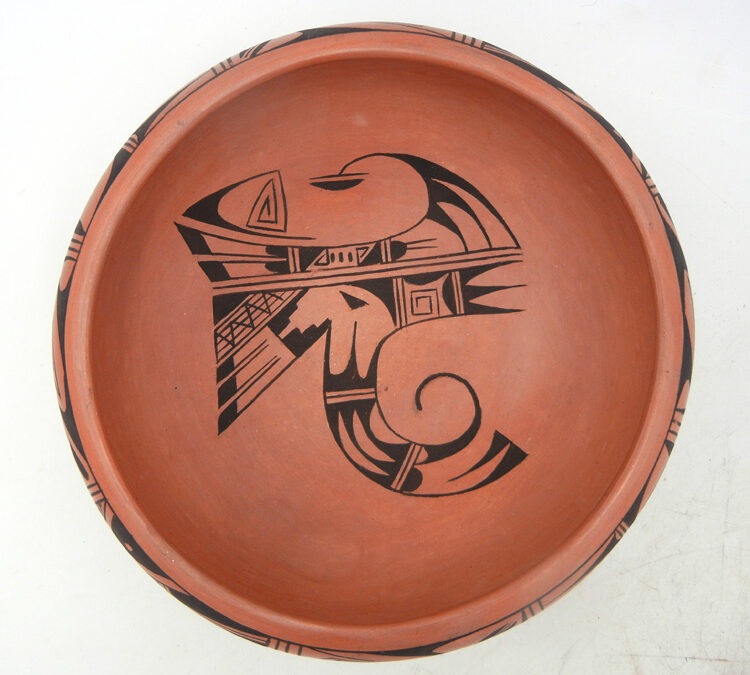Hopi is the shortened version of Hopituh Shi-nu-mu. The Hopi people refer to themselves as “the peaceful people.” This Native American tribe has resided in the four corners area of the Southwestern United States, where the corners of Arizona, Colorado, New Mexico, and Utah meet, for thousands of years.
The Hopi people have a rich and fascinating history that has been passed down through generations, which includes their origins, way of life, culture, spiritual beliefs, and arts.
At Palms Trading Company, we honor our Hopi neighbors by selling Hopi Pueblo pottery, jewelry, and kachina dolls bought directly from artisans. We find it crucial to share their history and art with you and want you to know more about their culture.
Hopi Origins and History
The Hopi people believe that they were created by their ancestors, the Kachina spirits, who came from the underworld to the earth’s surface. According to Hopi legend, the Kachina spirits helped the Hopi people survive and thrive in the harsh desert climate of northeastern Arizona.
The Hopi people have lived in the same location for thousands of years, which has allowed them to develop a deep connection to the land and its resources.
The Hopi people have a long and complex history, which includes a series of migrations and interactions with neighboring and incoming tribes such as the Navajo. The tribe has developed a unique way of life that is centered around their spiritual beliefs and maintaining balance and harmony with nature and their community.
Hopi Culture and Spirituality
The Hopi people have a unique culture that is deeply intertwined with their spiritual beliefs. They believe in a complex system of gods and spirits, including the Kachina spirits who helped create their people. The Hopi have developed elaborate rituals and ceremonies to honor these spirits, including Soyal, the winter solstice festival welcoming back the sun for blessings of a new year.
The Hopi people also believe in the concept of balance and harmony, which is reflected in their way of life. They highly value humility, generosity, and respect for all living things.
One of the most essential aspects of Hopi culture is their language. Despite the Hopi people descending from the ancient Aztecs, their language closely resembles Nahuatl. Like many indigenous tribes, the language is beginning to be spoken less by younger generations, but efforts are being made to preserve it.
Hopi Pueblo Pottery and Art
The Hopi people are well-known for their intricate Pueblo pottery, which has been an important part of their culture for thousands of years. Hopi Pueblo pottery is handmade using techniques passed down from their ancestors.
The clay used for their pottery comes from the land around them, and once gathered, ground with potshards added to stabilize it for firing. After adding water, the Hopi use a coiling technique involving creating ropes of clay and then layering these long coils on top of each other to create the desired shape. Potters then smooth out the coils using a gourd or wood before allowing it to air dry.
Once dried, a colored clay called a slip is applied to stabilize the color of the pottery when fired. Hopi artisans then use yucca brushes to apply their intricate designs ranging from geometric shapes, spiritual symbols, and depictions of nature.
Hopi Pueblo pottery is fired only once outdoors to complete the pottery-making process.
Hopi Pueblo pottery is highly prized by collectors and art enthusiasts worldwide and has been featured in museums and galleries.
In addition to pottery, the Hopi people also produce beautiful jewelry, baskets, and textiles, which are also highly regarded for their quality and craftsmanship.
Hopi Architecture and Agriculture
The Hopi people are also known for their unique style of architecture. The Hopi Pueblo is a collection of adobe buildings built on top of each other, with the upper levels accessible only by ladders. Adobe is a mixture of clay, straw, and water, designed to blend seamlessly with the surrounding landscape.
These structures are very much like our modern apartment buildings of today.
Each adobe space was home to one family, and an entire adobe house could contain an entire clan. It’s not uncommon to see some of today’s Hopi living in adobe dwellings, much like their ancestors did.
The Hopi people have developed innovative techniques to farm the land, including using terraced fields and irrigation systems to grow crops such as corn, beans, squash, and melons. These systems allowed them to develop sustainable farming techniques which used the land without depleting its resources.
The Hopi also developed a trading system with neighboring tribes, which allowed them to acquire resources they couldn’t obtain on their own, such as cotton for clothing.
The Hopi House
With the introduction of the Santa Fe Railway leading into Arizona during the 1800s, tourists became enamored with Hopi culture and art. Entrepreneuring entities like the Fred Harvey Company realized they could capitalize on the tourists’ fascination with Hopi culture and the Grand Canyon.
In 1905, the Hopi House opened on the South Rim of the Grand Canyon. The Hopi House was built using traditional materials and modeled after Pueblo architecture. This business employed Hopi dancers, artisans, and tour guides to perform for tourists and take them to their reservations.
The Hopi House still exists today at the Grand Canyon National Park.
Find Authentic Hopi Pueblo Pottery and Jewelry at Palms Trading Company
At Palms Trading Company, we offer the finest selections of authentic Hopi Pueblo pottery, jewelry, and kachina dolls. All our pieces are bought directly from the artisans, ensuring what we sell is authentic.
Trying to find that perfect gift for that special someone? Reach out to one of our personal shoppers, and they’ll be able to give you suggestions to fit their tastes.
Shop online or visit our Albuquerque store today to preview our collections of Hopi Pueblo pottery, jewelry, and kachina dolls.



